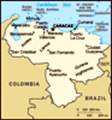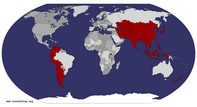Advertisement
Published: September 11th 2008
Think Venezuela and you don't normally think of the Andes, but the last 400km of the Andes does indeed reside here. We're not talking little mountains either, these puppies are up to 5,000m high.
From Maracaibo we took what should have been an 8 hour night bus to Merida. It was by far and away our crappiest night bus and had precisely zero leg room and the journey took 3 hours longer than it should because the bus kept breaking down.
The biggest town in the Venezuelan Andes, Merida is used to seeing tourists and so was very welcoming. We soon found a 'cheap' (by Venezuelan standards, not by ours) hotel after confirming that yes the LP options had massively inflated their prices and headed off to explore the town and get some money.
We wandered round a few streets expecting someone to approach us for black market trading which is supposed to be rife and for which we'd stocked up as best we could on US dollars, but with no result we resorted to an ATM. After trying almost every ATM in town we went into a bank and were told that no ATM in Venezuela would
take a foreign card! We have never had a problem with a single ATM in any other country AND our wonderful mis-guide book says ATMs are the best way to get money in Venezuela AND even the UK Foreign Office advice is that ATMS are only difficult to withdraw money from
sometimes. The problem is a 2 digit identification number that all the machines require after your PIN number. If you don't live in Venezuela you don't have one and can't use them. The Visa/Mastercard signs on them are the biggest false advertising ever!
Helpfully one of the bank people pointed us to the only bank in town that will do a cash advance on a foreign credit card. Having not eaten that day we were mighty happy to finally get money at 3pm, 4 hours after we first started trying. We dived out and got food and bumped into 2 other gringos who had been in the bank, who of course were in exactly the same situation and were very happy to hear that we'd been successful. Later that afternoon we topped up our funds by changing some US dollars with a tour agency near the Teleferico -
the black market is rife, its just not overt and you have to ask around tour agencies in a slightly discrete way.
The Teleferico is Merida's main tourist attraction - its the world's longest (about 12km) and highest Teleferico but after breaking down numerous times its now closed for 2 years as one of the towers collapsed and its wrecked the wiring which all now needs to be replaced. We were happy to hang around the town for a couple of days taking in the mountain backdrop and occasionally wandering the streets in what is a safe and clean city.
Originally after Merida we were thinking of heading back to the coast but already being sunburnt and finding Merida way too hot we decided to spend the bulk of our time in the mountains exploring the small towns and villages, at a temperature our bodies are slightly more comfortable with, before heading to Caracas.
So from Merida we took a local bus to Mucuchies. The only information we had on the places we were going was a brief description from the local tourist office information and we knew that accommodation may be difficult to find. Sure enough
whilst we found several places to stay in Mucuchies they were all full, we told ourselves this must surely be due to the protest/gathering of people that was going on there. The setting was nice, but the plaza seemed to be quite new and didn't really fit with the town. The really interesting colourful shops were on the main road through the village which was very narrow and full of constantly queued up traffic, much of it tourist traffic (we knew that we'd be hitting the end of the tourist high season and it was a Sunday). So we got another bus to San Rafael further up the road.
San Rafael was a total contrast, it's a quiet Andean village (once all the domestic tourists have left on a Sunday afternoon). With great views down a valley and a cute stone church with a museum next door. It's famous for the trout farmed in the area and is much cooler than Merida due to sitting at the respectably high altitude of 3,142m. We found somewhere to stay for a reasonable price no problem and spent the afternoon having a casual wander. That night we were reminded just how cold
it gets at high altitude and were very glad to have not posted all of our thermals home.
The next day we headed out to a one of the local tourist sights Lake Mucubaji which resides at 3,350m. We got a bus through the next couple of villages to the junction where the main road forks, where we encountered much confusion as to which side of road to stand. After asking around the only definitive answer we could get was "take a taxi" we later discovered this was how the locals get around in the mountains, but we bet they weren't be charged anywhere near the prices we were quoted by the taxi drivers.
So we decided to start walking down the road with the idea of flagging a bus, but none went past and after walking about 3kms uphill (at altitude) we asked some guys in a pickup how much farther it was and they offered us a lift in the back. Never ones to turn down a ride in the back of a pickup we jumped on.
The lake has a beautiful setting and we imagine a stunning mountain backdrop although with intermittent low cloud
it was hard to tell. Its not a big lake but was a great place to spend the day and we had a nice walk down the valley ending at a waterfall, however the cloud thickened and rain came in so we headed back to the lake and relaxed there for a while.
Eventually we headed back to the road to try and flag a bus. Amazingly after 5 minutes a bus arrived, but first they were stopping for some food so we hung around and waited for them to finish. We got back to San Rafael just before heavy rain set in for the remainder of the afternoon. We only ventured out once more that day to find food and sampled the local trout.
The next day we caught a bus to the last village before the junction (the local buses end at the junction) where we hoped to get a bus to Santo Domingo. After being there a good while with not a single bus going our way (there were plenty going the other way) we did the only thing you can do in the Andes when there's not a bus, stuck out our thumbs to
try and hitch a lift. The third truck that went past stopped but was going the wrong way at the forks ahead. 1/2 hr later another car stopped but was also going the wrong way. We decided to get a bus up to the junction and from there we decided to start walking down the right road and see if we could flag a bus or hitch. We'd only gone 200m when it started to rain pretty heavy, so out came the waterproof jackets and we prepared to have a hard slog in cold heavy rain, but just after taking a photo to record our wet adventure a car stopped and we hitched a ride in a shed on wheels with a guy called Jose from Merida and his 18yr old son, all 4 of us squashed into the front seat.
The scenery beyond the lake is amazing, and we had a lot of time to appreciate it as our shed only went as fast as 20kph (good job as the doors didn't really shut) as we discussed God and Catholicism, teenage pregnancy in Venezuela and how Jose was a changed man after recovering from a drink problem 10
years ago. It was a great ride.
Santo Domingo turned out to be a lovely town nestled in the hills and with help from the woman in the local tourist information found a posada which was like a rustic apartment (we had a separate living room/kitchen) and a total of 4 beds. We soon found the local bakery and whilst having cake and coffee rain started bucketing it down and cloud dropped on the town. Not being able to see or do anything we had an enforced rest before heading to the nearest viewpoint in town when it cleared.
Observations:
* People don't usually approach you but if you talk to them they are really helpful and will chat to you for ages.
* Public transport is a lot less frequent than other places we have been
* People drive sensibly and slow down to let you cross the road
Advertisement
Tot: 0.085s; Tpl: 0.017s; cc: 11; qc: 30; dbt: 0.0365s; 1; m:domysql w:travelblog (10.17.0.13); sld: 1;
; mem: 1.1mb

























